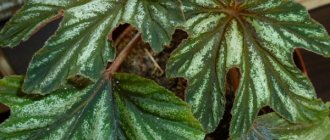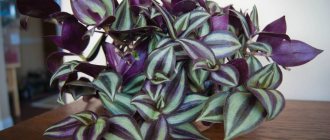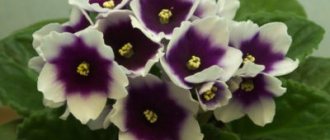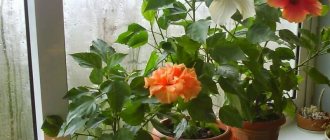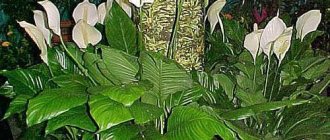History of the legend
Chlorophytum was brought to Europe more than 200 years ago from tropical rainforests. Even Johann Goethe, a German writer, grew this amazing flower and, having admired the chlorophytum, wrote his immortal works.
Scientists did not know which family to assign it to. They never came to a consensus. Some say this is the Agavov family, others say the Asparazhev family.
Thanks to its unusual appearance, chlorophytum has acquired many other names: Merry Family, Splash of Champagne, Green Lily. The flower has another name: “Bride’s Veil” for its resemblance to wedding decorations.
It was difficult for the flower to live in the wild, but when it moved into people’s homes, it simply “bloomed.” Owners of this flower should know that it kills germs, saturates the air with oxygen, and purifies the indoor air of harmful substances.
If you plant 3-4 bushes around the house, they will clear up to 10 square meters. meters of area from harmful toxins and pathogens. In addition to cleansing and saturating the space with oxygen, the flower moisturizes the air.
Chlorophytum blossoms sign. general characteristics
Homemade chlorophytum (photo shown below) has a lot of useful qualities. This plant can often be found in public institutions.
At home, the flower has a much more well-groomed appearance. Therefore, you should definitely consider it as an option for your home, even if you didn’t like the plant in a public reception area one day.
Because of its sharp leaves, chlorophytum has received many different names. The most famous of them are “green lily”, “flying Dutchman”, “veil’s wife”. Whatever it is called, the decorative qualities of the plant cannot be taken away.
This is a perennial herbaceous plant. Its stem is drooping. The leaves fall in bunches. Their shape is linear or slightly curled. The leaves of Chlorophytum are of the basal type.
The plant blooms quite beautifully. Loose panicles are white in color. They consist of small flowers. Well-developed representatives of the species have a large number of hanging stems. They have sockets.
Description of the plant
It is perhaps difficult to find a person who does not know what chlorophytum looks like. The flower stands out among other flower crops with thin leaves of different colors that hang down in a cascade.
Chlorophytum has a lush, even elegant appearance at any time of the year. If its leaves curl, an even more magnificent and beautiful shape is obtained.
With good care, chlorophytum will outshine many domestic specimens with its splendor and beauty. Today, several varieties of this crop have been developed, which differ in the width and color of the foliage. Their color can be striped or plain.
Chlorophytum grows as a compact bush. Over time, it begins to produce small rosettes, which, when planted in another container, quickly take root and produce a new lush flower.
Characteristic features of all varieties:
- The bush has leaves in the form of a lancet or oval 20-50 centimeters high. They emerge immediately from the root rosette.
- Leaves that grow up to 60 cm have a beautiful bend.
- The green plate in some species has a light or white border, rarely a yellow stripe in the center of the leaf.
- The roots are large, collected in a bunch. When there is a shortage of water, small nodules form on the roots, where there is a supply of moisture. Due to them, the plant tolerates drought in the wild tropics.
- In spring, flexible peduncles grow from the center of the rosette, on which small white flowers appear. The exotic blooms all summer long.
- After flowering, seed pods or shoots with aerial roots form on the stem.
- The life of a flower lasts 10-15 years.
Home care
Lighting
When choosing a place for a container with chlorophytum, you should focus only on personal taste preferences. It doesn’t matter to the plant whether it will be in a sunny place, or stand in a shaded corner, or whether it will be illuminated by decorative lamps. However, you should not burn the foliage of chlorophytum with scorching sunlight or keep it in complete darkness.
Temperature
Chlorophytum prefers moderate temperatures from 18 to 25 degrees. But the plant will not show its appearance, even if it is very hot, and can exist when the temperature drops to +10.
But chlorophytum does not like winds and reacts poorly to through ventilation.
Watering and humidity
The plant is absolutely not demanding on the quality and temperature of water. It should be watered generously 1-2 times every ten days. The frequency of watering is determined by the drying rate of the top layer of soil.
Chlorophytum does not react in any way to humidity or dry air. Therefore, it will live both in a very humid room and in a very dry one.
Remove dust from the foliage very carefully using a spray bottle. You should not wipe the leaves with a napkin or sponge, as they are very brittle.
Priming
Chlorophytum also does not make any demands on the soil. It will grow in any substrate, including hydroponics, pine bark, sand-peat mixture or ordinary garden soil.
Fertilizers
If chlorophytum is not fertilized, then there will be no tragedy for it. But if you want the plant to grow more intensively and have a very lush appearance and bright color, then it can be fertilized once a month with liquid fertilizers for deciduous plants.
Correction of shape and height
Chlorophytum grows at incredible speed. It is this property that sets it apart from other indoor plants and makes it possible to quickly create corners of greenery in any room.
However, the size and growth rate of the bush should be controlled, otherwise it will quickly take over the entire space. A “diet” will help slow down the growth of the plant and prevent it from producing new shoots. Namely, you need to keep chlorophytum at low temperatures, do not fertilize, reduce watering and reduce daylight hours. But if you want the bush to become voluminous, then, on the contrary, you need to increase the influence of light, heat and water.
You can also control the growth and shape of the plant by weekly trimming the leaf arches, removing them directly from the root rosette.
Transfer
The signal for replanting is the growth of the root system, when the stems of the roots begin to stick out on the surface of the substrate. In this case, the plant should be immediately moved to a larger container.
Popular types and varieties: names with photos
In the wild, chlorophytum has more than 200 varieties. As a rule, in tropical forests this plant lives on the bark and roots of trees. Only a few varieties of this crop are grown at home.
A photograph of each species will demonstrate the beauty of this green pet. Other species out of 200 are very rare. They can be seen in large greenhouses only by the most avid gardeners.
Chlorophytum crested (Chlorophytum Сomosum)
Most often in homes you can see Crested Chlorophytum with long, oblong leaves that grow from the very root. With good care, the flower rosette can become very lush, growing up to 50 cm in diameter.
A distinctive feature of Crested Chlorophytum are long shoots, at the end of which lush shoots with thin leaves and rarely flowers are formed. Thanks to this feature, it is often compared to a fountain or “splash of champagne.”
Cape Chlorophytum (Chlorophytum Capense)
Cape chlorophytum has a special shape and color of foliage, which is why it differs from other varieties. The flower itself grows compactly, but can produce leaves up to 50-60 cm in length.
The border of the foliage is painted in cream shades. For this rarity, the flower is very popular. As it grows, it becomes lush and attracts attention.
Chlorophytum Bonnie
Chlorophytum Bonnie is an attractive plant that fits perfectly into any apartment decor. Its curly leaves look great both in a hanging pot and on a high stand.
The exotic throws out long branches with rosettes. The rosettes can be planted in a pot, and they will again produce a lush bush of charming chlorophytum.
Chlorophytum must be planted in a house where there are a lot of household and electronic appliances and the floor is covered with synthetic materials. It ranks number one among green pets with amazing indoor air purifying abilities.
If there are 2-3 bushes in the room, then attacks in asthmatics are reduced, coughing is reduced in those who suffer from diseases of the lungs and the entire respiratory system,
Winged chlorophytum or orange chlorophytum (Chlorophytum Amaniense)
This variety is endowed with wide leaves with a bright orange color in the rosette itself. The flower grows over 50 centimeters in height and has a luxurious exotic appearance. This is a wonderful decoration for any interior.
Bonnie curly or curly
Unlike Crested Chlorophytum, the curly variety is smaller in size. Its leaf blades are so dashingly curled into spirals that they give Bonnie beautiful curls.
In the center the leaves are colored in light shades, and at the edges they are green. It is unpretentious and has the same beneficial properties as other varieties of this culture.
Ocean (Ocean)
"Ocean", brought to us from South America, takes root well at home. It grows up to 25 centimeters in height.
The bush grows without a stem. Greenery immediately begins to grow from the roots. Its rather wide green leaves with white edges can go down 60 centimeters.
Laxum (Chlorophytum Laxum)
Chlorophytum Laxum is an indoor flower of incredible beauty and is very rare. But if you become the owner of this beauty, it will bring good mood and comfort to your home.
The thin, delicate leaves with a white border are mesmerizing. The size of the variety is small, so it can fit on any shelf, decorating the interior.
This is a very rare variety of evergreen Chlorophytum, and therefore is highly valued by gardeners.
Atlantic
The flower grows 20-30 centimeters in height. Loves diffused light and warmth. Chlorophytum blooms in summer, releasing buds collected in groups of 1-4 pieces. Their white color with an orange tip gives the flower a rare originality. The variety was bred in Holland quite recently, in 2007.
It is distinguished by a neat rosette, up to 20 cm in diameter. In the center of the leaves there is a white, rather wide stripe with a pale green border. The leaves are 25 cm long and 2 cm wide.
Lemon
A short, compact plant that can grow in any conditions, but loves good light and regular watering.
Chlorophytum "Lemon" is a luxurious flower with glossy, solid green leaves with a light stripe. The green mass is collected in bunches that resemble tufts. In spring it pleases with white stars.
The bush has 2 tiers of shoots, and with good care it can produce a third tier. Looks incredibly beautiful on a high stand with the leaves cascading down.
Variegata
Chlorophytum Variegata came to us from South America. It grows very quickly, acquiring beautiful curved leaves right from the root. In spring it produces thin stems on which small white flowers bloom, and then tiny rosettes.
For comfort, chlorophytum requires a comfortable pot, good lighting, a humid and warm corner, and regular watering. For good development of green mass, nutritious soil and fertilizers are required.
Let's take a closer look at how to care for tropical exotics.
Growing conditions
In order for chlorophytum to grow well, you need to choose the right growing location and plant it in suitable soil.
Choosing a growing location
Chlorophytum lives in tropical forests, where it is not exposed to direct sunlight. The plant adapts well to the prevailing lighting conditions, so it also grows well in heavily sunny and semi-shaded positions. However, immediately after purchase you should not expose it to direct sunlight, otherwise it will quickly begin to lose its leaves, and therefore its decorative qualities.
Sunny places are more favorable for two-color varieties of chlorophytum, because thanks to this the stripes on the leaves become better colored - in the shade the leaves acquire a uniform green color. Do not expose the plant to prolonged direct sunlight; intense sunlight will burn the leaves. A window sill located in the east, northeast or northwest is better suited.
You can grow chlorophytum on the balcony, outdoors, in a box, where it looks great accompanied by flowering seasonal plants. It is also planted in flower beds. However, before the onset of frost, it needs to be transplanted into a pot and kept in the apartment in winter. It is not recommended to expose it to strong winds - the leaves are quite fragile.
Optimal temperature
Optimal temperature for growing chlorophytum:
- in summer – 18-20 degrees Celsius;
- in winter – 8-10 gr.
The plant tolerates temperature fluctuations within 12-30 degrees. It is quite resistant to cold - it can withstand temperatures down to 0 °C, so it can remain on the balcony until October. In open ground in winter, chlorophytum freezes with the appearance of frosts below -3 degrees Celsius.
You cannot place chlorophytum near a heating radiator; dry air will damage its leaves.
What kind of soil is needed?
The soil for chlorophytum should be:
- fertile;
- permeable;
- slightly damp;
- with a slightly acidic pH (values in the range of 5.5-6.5).
Regular universal flower soil will do, but you should loosen it with gravel, sand or vermiculite, in a ratio of 1 handful of baking powder to 3 handfuls of soil. But there is no need to weaken the soil with perlite, because it contains fluorine, to which chlorophytum reacts poorly. The plant is also great for hydroponic growing.
Methods for propagating chlorophytum
Chlorophytum is easily propagated by dividing the bush, children and seeds.
Seeds
How to propagate chlorophytum by seeds? Seeds can be bought at the store. They are first soaked for a day, placed on a damp cloth. You can soak it on damp toilet paper, placing several layers in a food container with a lid.
If the sprouts hatch, they should be planted in any moist soil, covered with film, and placed in a warm place.
When the shoots appear, transplant them into a container for germination and the appearance of true leaves. Then they are picked and transplanted one by one into a separate container.
By division
It is better to propagate by division when transplanting. When you start replanting an adult specimen, divide it into several parts, leaving roots on each part. Transplant each part into a pot with nutritious soil and water.
Children rooting rosettes
The best propagation is by rosettes that hang on flexible shoots. Plant the baby with the aerial root immediately in a separate pot. In a couple of weeks it will take root and grow, overgrown with foliage.
If in doubt, place the roots of the rosette in a glass of water. When root shoots appear, transplant into a flowerpot.
Diseases, problems, pests and treatment
Chlorophytum almost does not get sick. If spider mites appear, rinse the plant under warm water. Chlorophytum is rarely treated with chemicals. A warm shower is the best treatment for this exotic.
But stagnant water in a container can lead to mold and root rot. After watering, immediately pour out excess water from the tray. Pests such as scale insects, aphids, and spider mites can attack plants that grow on the balcony. Rinse also in a warm shower. If it doesn’t help, then treat with any insecticide.
Problems
Although growing chlorophytum is a fairly simple task, some problems may arise due to unsuitable conditions, improper care, diseases or pests.
Chlorophytum leaves drying out
If the tips of the leaves of a plant have darkened and dried out, this does not mean that the chlorophytum itself is drying. For this plant, the death of old leaves is a natural process. Therefore, if the number of dry leaves is not too large, and only old leaves dry out, you don’t have to worry about this.
Chlorophytum on the coffee table
If the tips of almost all the leaves dry out, this may indicate a lack of moisture. To improve the situation, you can regularly spray chlorophytum with warm water.
Diseases and pests
Homemade chlorophytum flowers are not only unpretentious, but also quite resistant to various diseases and pests. A weakened plant can be attacked by aphids or scale insects. In this case, he needs to be isolated and treated with special drugs.
Chlorophytum in a hanging pot in the garden
Drooping, soft and pale leaves indicate that the flower is too hot or does not have enough light. Brown spots indicate low temperatures and overwatering. If the plant stops producing arrows with flowers, it should be transplanted into a larger pot.
FAQ
Most often, gardeners are concerned about the drying tips of the leaves. And one more question - how to relate to the superstitions associated with this flower?
Why do the leaves of chlorophytum turn yellow and dry, what should you do?
Why do the tips of Chlorophytum leaves dry out? This is a fairly common problem. Most often, the ends dry out from the heat in the room. Spray it with a spray bottle and place an open container of water next to it.
Check to see if your flower takes too much fertilizer? Overfeeding is just as harmful as underfeeding.
The tips of the leaves are still drying from insufficient watering. Tropical exotic loves air humidity and watering.
If you do everything correctly and the tips remain dry, then inspect the plant for insects. Among the pests, mealybugs, spider mites, and thrips can attack the flower. Rinse them off in the shower or treat them with Aktar.
Chlorophytum may undergo a natural process of green renewal. Old leaves die off, and then young shoots grow in their place.
This process also begins with the tips of the leaves drying out. Remove the yellow leaf, making way for the young sprout.
Is it possible to leave chlorophytum without care during the holidays?
If you often go on business trips, then wick water the flower or put vermiculite in the soil. It will not let your green pet dry out.
Is it possible to keep chlorophytum at home: the benefits and harms of a kitchen flower
The benefits and harms of flowers have long been of interest to all gardeners. Everyone knows from the first grade that it purifies indoor air from fumes, tobacco smoke, and harmful toxins.
It also absorbs ammonia, carbon monoxide, acetone, benzene, formaldehyde and other harmful compounds.
Flower parasites are also reluctant to attack this exotic crop. And no one knows anything about the harm.
But it can be harmful to children and pets who like to try something new. It is better to place this flower higher away from children so that they cannot reach it. Just the sharp edges of the leaves can injure the delicate skin of the child’s lips.
And if we talk about feng shui, the residents of China claim that this tropical resident brings comfort and peace into the house, protecting the home from bad energy.
The Chinese often give this flower to those who work very hard so that they can relax and have fun a little more.
Is it dangerous for cats?
Many cats love to chew indoor plants. They find them by their pleasant smell. But many green pets can become deadly to them. Chlorophytum often becomes the object of chewing by furry owners.
A cat can be discouraged from the flower if you follow the breeders' recommendations:
- Place or hang the pots as high as possible - out of reach for the prankster.
- Use sprays with a repulsive citrus scent. To prevent the cat from touching the plant, just spray the leaves with citrus juice. You can use a commercial spray.
- If the rosettes are hanging down and “teasing” the cat, then they need to be cut off and placed in other containers.
- Grow a special grass that all cats adore.
- If your cat likes to chew plants, then more vitamins need to be added to the diet.
Growing and caring for chlorophytum
This amazing flower does not require any special soil; any soil will suit it. The same goes for choosing a pot. It grows superbly both in rooms with bright sunlight and in shady areas. Not afraid of either high or low temperatures. Feels great on a nightstand or in a flower pot on the wall. In a word, this is a godsend for lazy people, or people who sorely lack time to grow indoor plants.
Note! For leisure activities, we recommend visiting the handicraft portal for beginners https://gidrukodeliya.ru - a large selection of exclusive ideas is presented here.
What is also interesting about chlorophytum is its unpretentiousness to watering. If you don’t water it for a long time, up to a month, it won’t die, just the leaves of the chlorophytum will become a little sluggish, and if, on the contrary, it receives excessive watering, it will grow a gorgeous root system with shoots in the form of arrows, which makes it even more attractive.
Read here Cardamom: properties, uses, indications and contraindications for growing a fragrant flower indoors. 115 photos of ornamental plants
What are his escapes worth? They are miniature copies of the mother bush, attached to the ends of dense twigs going down.
Thanks to excessive watering, the root system does not rot, but rather expels many additional leaves to get rid of excess moisture.
In a word, having got chlorophytum at home, you can safely go on vacation or on business trips; it will always wait for its owner at home.
Interesting facts about chlorophytum
It has been noticed that signs and superstitions associated with chlorophytum are only positive.
Feng Shui
According to the teachings of Feng Shui, chlorophytum is the safest plant for a home and its inhabitants. It thoroughly absorbs negative energy and releases positive energy instead.
If suddenly a flower begins to fluff up, produce babies and become prettier right before our eyes, it means that it absorbs all the carbon monoxide, nitrogen and everything that is bad in the house.
It is recommended that after a difficult event, sit down next to the “doctor” and talk about your sorrows. After a few minutes of conversation with chlorophytum, a person will be in a good mood.
It transmits male “Yang” energy. To balance the energy, you can place “female” flowers (violet, crassula) nearby. If the flowerpot is placed on the north side, career advancement or other positive changes in the life of the owners of this plant will begin.
Useful tips
When choosing plants for the kitchen, you need to consider the following parameters:
- flower size;
- location;
- location relative to heating devices;
- changes in humidity and temperature.
It is very important to consider the size of the plant. A huge flower in a small kitchen would be completely inappropriate.
It is worth considering the location of the plant in the kitchen. It should not interfere with cooking. Avoid placing plants near refrigerator or cabinet doors that open frequently. Also, hanging pots with flowers should not hang very low above your head.
The kitchen is full of appliances that get hot. This is dangerous for plants. That is why you should not place flowers next to an electric kettle, stove, toaster, oven, or bread maker. This may destroy the plant.
During cooking, there may be changes in humidity and temperature, which is why it is worth choosing the right flowers that will not be afraid of all these negative conditions. Here are a few plants that are just perfect for your kitchen space.
